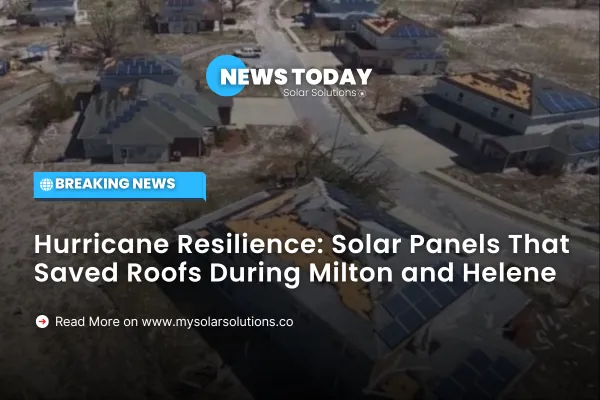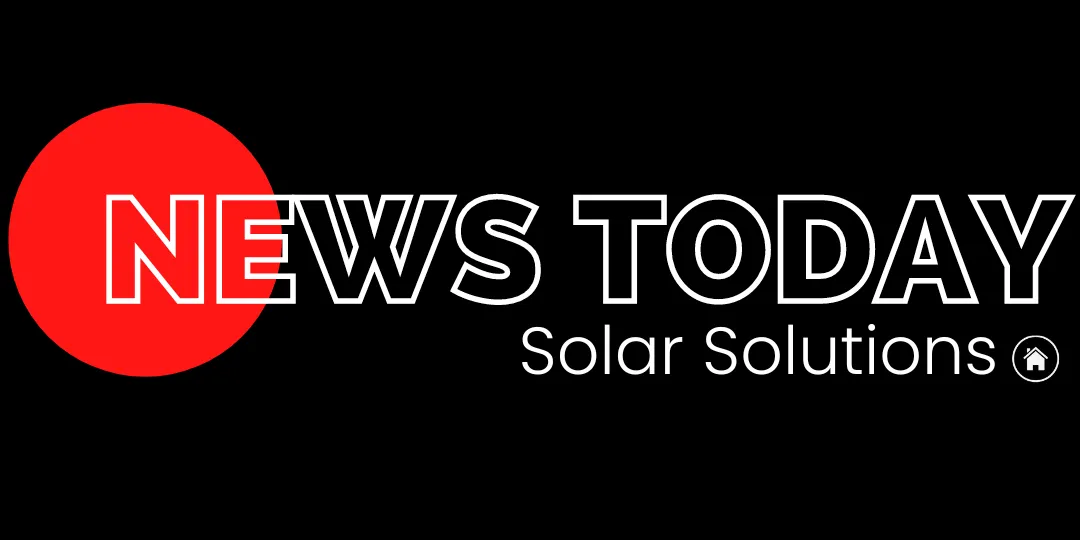NEWS
BREAKING NEWS

Hurricane Resilience: Solar Panels That Saved Roofs During Milton and Helene
When it comes to severe weather, especially hurricanes, our thoughts often turn to the devastation they cause. Recently, Florida faced two formidable storms: Hurricane Helene and Hurricane Milton. Helene, striking as a powerful Category 4 storm, made landfall on September 26. With winds howling at 140 mph, it left over a million people without power and caused extensive flooding. Shortly thereafter, Hurricane Milton hit on October 9 as a Category 3 storm, bringing 120 mph winds and leading to significant destruction, flooding, and at least 25 fatalities. But amidst the chaos, one question lingers: how did solar panels hold their ground during these intense storms? Spoiler alert—it turns out they demonstrate remarkable resilience.
Understanding Solar Energy Systems and Their Durability
What Makes Solar Panels So Tough?
Solar panels are often perceived as delicate devices, but this couldn’t be further from the truth. The engineering behind these energy-generating systems is impressive, consisting of:
Tempered glass: Designed to resist impacts and withstand harsh weather conditions.
Aluminum frames: Strong yet lightweight, securing panels against high winds.
Advanced solar cells: Built to minimize damage risk even when the weather turns extreme.
The Engineering Behind Resilience
Solar panels undergo rigorous testing to ensure they hold up against various extreme weather events, from heavy rain to hail and strong winds. Many panels are certified to withstand sustained winds of up to 140 mph—mirroring the intensity of storms like Helene!
How Solar Stands Up During Storms
After storms like Hurricanes Helene and Milton, we often see reports of damage and destruction. Surprisingly, many solar energy systems fared well.
Post-Hurricane Assessments: In both hurricanes, numerous homeowners reported their solar systems remained completely operational.
Community Resilience: In heavily solar-populated neighborhoods, many homes reported functionality when others faced outages.
Solar Panels vs. Extreme Weather
Let’s explore how solar panels hold up against different storm elements:
1. High Winds
During Hurricane Milton, which brought winds of up to 120 mph, well-installed solar panels proved their endurance. Proper mounting is crucial; secure installations can withstand these conditions.
2. Heavy Rain
Rain falls and floods are common after hurricanes. Solar systems are designed to facilitate drainage and prevent water accumulation on panels, reducing the risk of water damage.
3. Hail
While hail can be a concern, modern solar panels undergo impact tests to ensure they can withstand hail sizes similar to golf balls—a reassuring factor during storm season.
Preparing Your Solar System for Storm Season
Regular Maintenance Checks
Setting your solar panels up for success requires regular maintenance, especially as storm season approaches. Here are some steps to consider:
Inspect for Debris: Before storms hit, clear any branches or leaves to maximize light exposure.
Check Mounting: Ensure your panels are securely fastened to their mounts.
Monitor Performance: Keeping an eye on performance can help identify potential issues before they escalate.
Backup Systems: Are They Necessary?
Despite the durability of solar panels, having a battery storage system can be your best line of defense. These systems store excess energy generated during sunny days, ensuring you have power even during outages caused by hurricanes.
Myths About Solar Panels and Storms
We’ve heard various misconceptions—let’s set the record straight:
Myth 1: Solar Panels Will Get Blown Off in High Winds
Truth: When properly installed, solar panels are designed to resist high winds and remain intact.
Myth 2: Rain Damages Solar Panels
Truth: Rain can actually enhance the efficiency of solar panels by cleaning them and allowing more sunlight to reach them.
Myth 3: Solar Panels Are Too Fragile for Hail
Truth: Panels are rigorously tested against hail impacts, assuring their resilience even during severe weather events.
The Environmental Impact of Solar Energy During Storms
Sustainability in Action
After hurricanes like Helene and Milton, many Floridians have turned to solar energy for recovery. Utilizing renewable energy reduces dependency on traditional power grids, which often get compromised during storms.
Solar Microgrids
In areas frequently impacted by storms, solar microgrids can maintain functionality even when the main power sources fail, providing critical energy support during recovery efforts.
Choosing the Right Solar Energy Provider
Here’s what to consider:
Reputation: Customer reviews speak volumes about service quality.
Warranty Offers: A robust warranty indicates confidence in product durability.
Local Expertise: Providers familiar with Florida’s unique weather conditions can tailor systems accordingly.
Selecting the perfect solar provider is a crucial step for every homeowner looking to adopt solar energy, and that’s where My Solar Solutions shines. This dedicated platform specializes in connecting homeowners with the right solar installers tailored to their specific needs and preferences. With a network of qualified and experienced professionals, My Solar Solutions assesses your home’s unique characteristics, energy requirements, and budget to recommend installers that are a perfect fit. Their user-friendly approach ensures that you not only find a trusted local expert, but you also receive personalized quotes and insights to facilitate informed decision-making. Whether you’re looking for a cost-effective solution or advanced technology, My Solar Solutions is committed to simplifying the process, making the journey to solar energy seamless and effective for homeowners. With their guidance, transitioning to solar power can be a hassle-free experience, ensuring your home is equipped with the best possible solar energy system to withstand even the toughest storms.
Financing Your Solar Project
Even with storms challenging our perceptions of resilience, investing in solar energy is a smart choice. Numerous financing options can make securing your renewable energy system more manageable, allowing families to embrace sustainable energy.
Solar Resilience Is a Bright Future
In the aftermath of Hurricanes Milton and Helene, the resilience of solar panels proves their worth. When installed properly and maintained well, solar energy systems can withstand formidable storms while providing essential power when we need it most. So, when the winds rise and the skies darken, rest assured that your solar panels are prepared to face the elements, ensuring security and sustainability for your home.
FAQs
1. Do solar panels work during power outages?
Yes! If equipped with battery storage, your solar panels can continue functioning during outages, providing power when needed most after events like hurricanes.
2. What kind of maintenance do solar panels require?
Regular maintenance includes cleaning debris off panels, ensuring secure mounts, and monitoring performance to identify issues early.
3. Can solar panels withstand hurricanes like Milton and Helene?
Absolutely! Modern solar panels are engineered to endure high winds, heavy rains, and impact, proving reliable even during strong hurricanes.
4. Are there solar panel designs that cater specifically to storm-prone areas?
Yes, many solar providers offer panels designed for higher wind speeds and resilience to harsh weather conditions.
5. Will heavy rainfall impact the efficiency of my solar panels?
Heavy rainfall often helps clean solar panels, potentially improving their efficiency. Panels are designed to operate even in less-than-ideal sunlight conditions.

